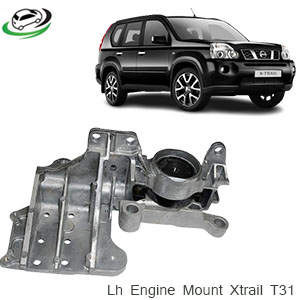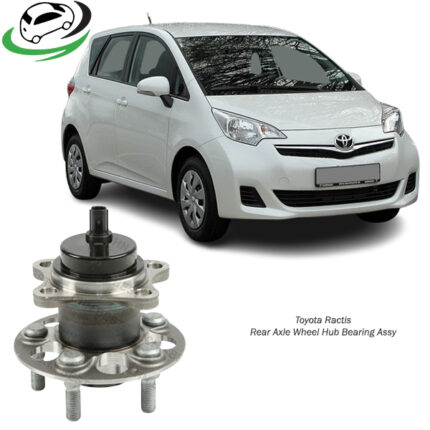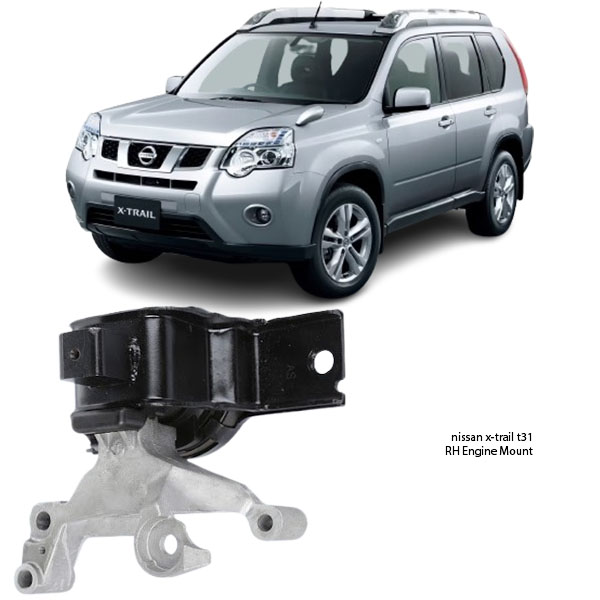-7%
Get Nissan X-TRAIL T31 RH Engine Mount 11210-JG000 in Kenya
The Right-Hand (RH) engine mount is a crucial component of a vehicle’s engine mounting system. It is responsible for securing the engine to the chassis while minimizing vibrations, absorbing shocks, and ensuring proper alignment. Engine mounts play a critical role in vehicle performance, comfort, and longevity, as they help reduce engine movement and prevent damage to other components.
This article provides an in-depth explanation of RH engine mounts, including their function, types, materials, benefits, signs of failure, and maintenance tips.
Function of an RH Engine Mount
The RH engine mount, located on the right side of the engine bay (usually the passenger side in left-hand drive vehicles), serves multiple functions:
1. Supporting the Engine
- The engine mount holds the engine securely in place, preventing excessive movement during acceleration, deceleration, and cornering.
2. Absorbing Vibrations and Shocks
- The mount acts as a cushion, absorbing engine vibrations and preventing them from transferring to the chassis and cabin.
3. Reducing Engine Movement
- Limits excessive engine motion, which could lead to misalignment of drivetrain components and premature wear.
4. Maintaining Proper Alignment
- Ensures the engine remains correctly positioned, allowing for efficient operation of drivetrain components such as the transmission and axles.
5. Enhancing Driving Comfort
- A properly functioning engine mount contributes to a smooth driving experience by reducing noise, vibrations, and harshness (NVH).
Types of RH Engine Mounts
RH engine mounts come in various designs to suit different vehicle applications and performance needs:
1. Conventional Rubber Engine Mounts
- Made from metal and rubber.
- Absorb vibrations effectively and are widely used in passenger cars.
- Affordable and durable but may wear out over time.
2. Hydraulic Engine Mounts
- Contain a fluid-filled chamber to provide better vibration damping.
- Commonly used in luxury and performance vehicles for improved comfort.
- More expensive but offer superior NVH reduction.
3. Active Engine Mounts
- Use electronically controlled mechanisms to adjust stiffness based on driving conditions.
- Found in high-end and performance vehicles.
- Reduce vibrations significantly but are costly and complex.
4. Polyurethane (Poly) Engine Mounts
- Made from polyurethane instead of rubber, offering increased durability.
- Commonly used in performance or modified vehicles for better engine stability.
- Provide less vibration absorption, which may lead to a rougher ride.
Materials Used in RH Engine Mounts
1. Rubber
- The most common material for standard mounts.
- Provides effective vibration dampening.
2. Polyurethane (PU)
- More durable than rubber and resistant to wear.
- Offers better stability but transmits more vibrations.
3. Metal (Aluminum or Steel)
- Used in the frame of the mount for structural integrity.
- Helps secure the mount to the engine and chassis.
4. Hydraulic Fluid
- Found in hydraulic mounts to absorb vibrations.
- Helps improve comfort and reduce harshness.
Benefits of RH Engine Mounts
1. Reduced Vibrations and Noise
- A properly functioning mount ensures minimal vibrations in the cabin, leading to a quieter and smoother ride.
2. Prevents Damage to Engine and Transmission Components
- By stabilizing the engine, the mount protects other components from excessive movement and stress.
3. Enhanced Vehicle Performance
- Ensures proper engine positioning, which contributes to efficient power delivery and handling.
4. Increased Engine Longevity
- Reduces unnecessary wear and tear on engine and drivetrain components.
5. Improved Driving Comfort
- Absorbs shocks and road impacts, preventing them from being transferred to the vehicle’s interior.
Signs of a Failing RH Engine Mount
Over time, engine mounts can deteriorate due to constant exposure to heat, vibrations, and engine torque. Some common symptoms of a failing RH engine mount include:
1. Excessive Engine Vibrations
- Increased vibrations in the cabin, especially when idling or accelerating, indicate a worn-out mount.
2. Clunking or Knocking Noises
- A damaged mount may allow the engine to shift excessively, causing knocking sounds during acceleration or braking.
3. Engine Movement
- If the engine shifts noticeably when revving the engine or changing gears, the mount may be broken.
4. Visible Cracks or Damage
- Inspect the mount for visible wear, cracks, or detached rubber.
5. Increased Transmission and Drivetrain Wear
- A worn-out mount can put extra stress on drivetrain components, leading to premature failure.
Causes of RH Engine Mount Failure
Several factors can contribute to the failure of an RH engine mount:
1. Wear and Tear
- Continuous exposure to engine vibrations and heat causes rubber mounts to degrade over time.
2. Oil or Fluid Contamination
- Oil leaks from the engine or transmission can weaken rubber mounts, causing them to deteriorate faster.
3. Aggressive Driving
- Hard acceleration, rapid gear shifts, and high-speed driving put extra stress on engine mounts.
4. Improper Installation
- Incorrect mounting or using low-quality replacement parts can lead to premature failure.
5. Excessive Torque and Load
- Performance modifications or towing heavy loads can strain engine mounts beyond their limits.
Maintenance Tips for RH Engine Mounts
To prolong the lifespan of your RH engine mount and ensure optimal vehicle performance, follow these maintenance tips:
1. Regular Inspection
- Check for cracks, leaks, or damage during routine vehicle servicing.
2. Monitor Vibrations and Noises
- Pay attention to unusual vibrations or knocking sounds and address them promptly.
3. Fix Oil and Fluid Leaks
- Ensure there are no oil leaks that could damage rubber mounts.
4. Avoid Aggressive Driving
- Smooth acceleration and braking help reduce excessive engine movement.
5. Replace Worn Mounts Promptly
- If a mount shows signs of wear or failure, replace it to prevent further damage to the engine or transmission.
6. Use Quality Replacement Parts
- Choose OEM or high-quality aftermarket engine mounts for better durability and performance.
Conclusion
The RH engine mount is an essential component of a vehicle’s engine mounting system, providing support, stability, and vibration reduction. Depending on the type and material used, engine mounts can enhance comfort, prevent excessive engine movement, and improve overall vehicle performance.
Regular maintenance, proper installation, and timely replacement of worn-out mounts can help ensure a smoother ride and prevent costly repairs. By understanding the function and importance of the RH engine mount, drivers can take the necessary steps to keep their vehicles running smoothly and efficiently.
Follow us on Facebook for more parts.



